Design and development
The B-20 was an attempt to combine the best features of both the flying boat and the floatplane. While on the water, the B-20 was essentially a floatplane, using a large float under the fuselage for buoyancy, and two smaller floats near the wingtips for stability. In flight, the main float retracted upwards towards the fuselage, fitting into a "notch" to become streamlined as a part of the fuselage. The wing floats folded outwards, somewhat like those on the American Consolidated PBY flying boat design, to become the wingtips. [2] This configuration gave the correct wing incidence for takeoff and for flight and in the latter a much reduced drag compared to the deep hulls of flying boats. [3]
Blackburn, along with Supermarine, Shorts and Saunders-Roe tendered designs against Air Ministry Specification R1/36. The Supermarine was chosen initially but Supermarine could not start work soon enough (due to their work on the Spitfire) and what would enter service as the Saunders Roe Lerwick became the chosen aircraft. However, the Ministry was interested enough to authorise and contract for the construction of a prototype of the B-20, serial number V8914, to test the concept.
Testing
The prototype, built at Dumbarton, flew for the first time on 26 March 1940. On 7 April, during a test run, the aircraft experienced extreme vibration due to aileron flutter and the crew bailed out. Three were lost, the other two were picked up by HMS Transylvania, a converted merchantman. Development ceased when the first prototype crashed, as Blackburn's resources were dedicated to the war effort. [1] The Ministry felt the concept had been proven and the crash was not due to the pontoon design.
The aircraft's wreck still exists, but remains undisturbed as it is designated a War grave. In 1998, one of the engines was raised as it had been caught in a fishing boat's nets and dragged away from the wreck, into shallower water. It is currently an exhibit in the Dumfries and Galloway Aviation Museum. [4]

Blackburn Aircraft Limited was a British aircraft manufacturer from 1914 to 1963 that concentrated mainly on naval and maritime aircraft.
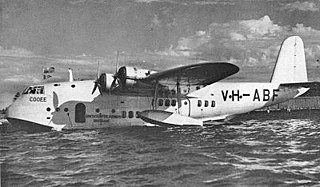
A flying boat is a type of fixed-winged seaplane with a hull, allowing it to land on water. It differs from a floatplane in having a fuselage that is purpose-designed for flotation, while floatplanes rely on fuselage-mounted floats for buoyancy.

A seaplane is a powered fixed-wing aircraft capable of taking off and landing (alighting) on water. Seaplanes are usually divided into two categories based on their technological characteristics: floatplanes and flying boats; the latter are generally far larger and can carry far more. Seaplanes that can also take off and land on airfields are in a subclass called amphibious aircraft, or amphibians. Seaplanes were sometimes called hydroplanes, but currently this term applies instead to motor-powered watercraft that use the technique of hydrodynamic lift to skim the surface of water when running at speed.

The Saunders-Roe SR.45 Princess was a British flying boat aircraft developed and built by Saunders-Roe at their Cowes facility on the Isle of Wight. It has the distinction of being the largest all-metal flying boat to have ever been constructed.

The Blackburn Roc was a naval fighter aircraft designed and produced by the British aviation company Blackburn Aircraft. It took its name from the mythical bird of the tales of the Arabian Nights, the Roc. It was operated by the Fleet Air Arm (FAA) and was active during the Second World War.

The Saunders-Roe SR.A/1 was a prototype flying boat fighter aircraft designed and built by British seaplane manufacturer Saunders-Roe. It was the first jet-propelled water-based aircraft in the world.

The Saunders Roe A.27 London was a British military biplane flying boat built by the Saunders Roe company. Only 31 were built, entering service with the Royal Air Force (RAF) in 1936. Although due for replacement by the outbreak of World War II, they saw some active service pending the introduction of the ultimately unsuccessful Lerwick.

The Saunders-Roe A.36 Lerwick was a British flying boat built by Saunders-Roe Limited (Saro). It was intended to be used with the Short Sunderland in Royal Air Force Coastal Command but it was a flawed design and only a small number were built. They had a poor service record and a high accident rate; of 21 aircraft, 10 were lost to accidents and one for an unknown reason.

The Blackburn Iris was a British three-engined biplane flying boat of the 1920s. Although only five Irises were built, it was used as a long-range maritime reconnaissance aircraft by the Royal Air Force, where it equipped a squadron for four years, being used to carry out a number of notable long-distance flights. The final version of the Iris, the Iris Mark V was developed into the aircraft that replaced it in Squadron service, the Blackburn Perth.

Pterodactyl was the name given to a series of experimental tailless aircraft designs developed by G. T. R. Hill in the 1920s and early 1930s. Named after the genus Pterodactylus, a well-known type of Pterosaur commonly known as the pterodactyl, all but the first were produced by Westland Aircraft Ltd after Hill joined them.
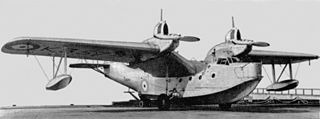
The Short R.24/31 was a British twin-engined, high-wing cantilever gull winged monoplane flying-boat designed and built by Short to Air Ministry specification R.24/31 for a "General Purpose Open Sea Patrol Flying Boat". The contract also specified the use of the experimental Rolls-Royce Goshawk engine. The Saunders-Roe London and the Supermarine Stranraer competed successfully for this contract.

The Blackburn Pellet was a single-engined, single-seater biplane flying boat designed as a contender for the 1923 Schneider Trophy competition. It was destroyed while taking off for the trials of the contest.
The Saro A.33 was a British prototype flying boat built by Saunders-Roe Limited in response to a British Air Ministry Specification R.2/33 and in competition with the Short Sunderland.
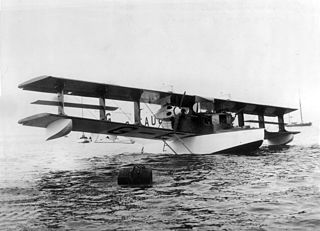
The Saunders Kittiwake was a British amphibian flying-boat built by S. E. Saunders at East Cowes, Isle of Wight. Only one was built, and it was scrapped after less than a year of testing.
The Westland N.1B was a prototype British single-engined floatplane fighter aircraft of the First World War. The first aircraft to be designed by Westland Aircraft, it was a single-engined tractor biplane. Despite good performance, only two aircraft were built, the Royal Naval Air Service operating landplane fighters from ships instead.
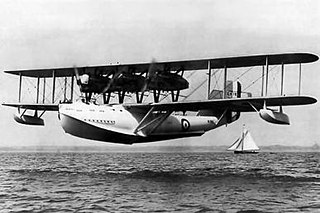
The Saunders A.3 Valkyrie was a large three-engined biplane flying boat with a wooden hull built to an Air Ministry specification. It was not found suitable for production and helped to confirm a preference for metal-hulled flying boats.
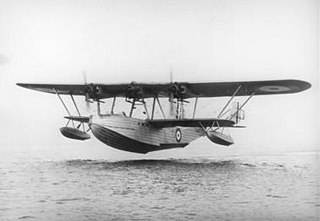
The Saunders Severn was a three-engined biplane flying boat intended for maritime patrol duties. It performed well but was fragile and unreliable. Only one was built.
The Blackburn B.44 was a British single-engined fighter aircraft designed by Blackburn Aircraft in 1942. It was notable as a rare example of a flying boat fighter, featuring Blackburn's unique retractable hull, and designed to meet the requirements of Air Ministry Specification N.2/42.
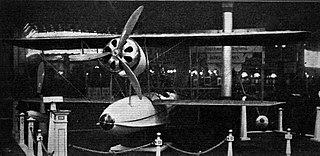
The Pemberton-Billing P.B.1, sometimes known as the Supermarine, was a 1910s British single-seat flying-boat built by Pemberton-Billing Limited, which later became the Supermarine Aviation Works. Only one P.B.1 was built, and it never flew any distance further than a hop.
The Macchi M.C.77 was a reconnaissance bomber flying boat built by Macchi in the thirties and remained at the prototype stage.
This page is based on this
Wikipedia article Text is available under the
CC BY-SA 4.0 license; additional terms may apply.
Images, videos and audio are available under their respective licenses.
















